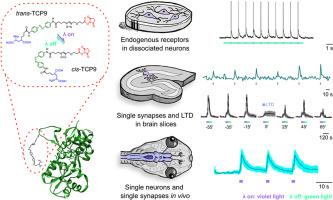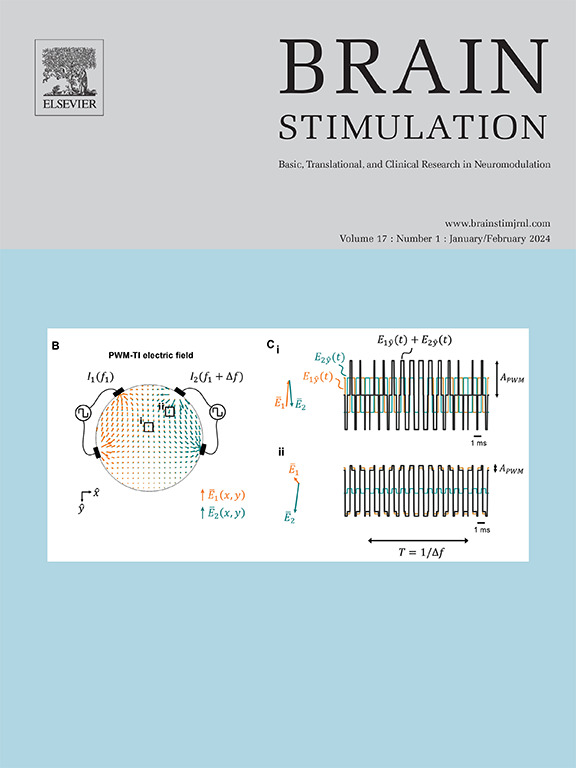体内光开关内源性谷氨酸受体在神经系统和单突触中的作用。
IF 8.4
1区 医学
Q1 CLINICAL NEUROLOGY
引用次数: 0
摘要
目的:研究动物体内生理,缺乏非遗传方法来控制内源性蛋白的活性,具有药理学和时空精度。为了满足这一需求,我们最近开发了靶向共价光开关(TCP)化合物,可以利用光远程控制内源性谷氨酸受体(GluRs)。方法:将光药效学效应物TCP9与神经元活动传感器相结合,在大鼠离体脑组织和爪蟾蝌蚪体内脑组织中展示内源性GluRs在多时空尺度上的全光可逆控制。研究发现:TCP9可以光激活离体组织和体内完整大脑中的神经元群、单个神经元和单个突触,这是用光遗传学和神经递质释放的挑战。TCP9共价靶向AMPA和kainate受体,在单一化合物应用后延长其功能和光切换性(bb0 - 8小时)。这允许在突触可塑性事件中跟踪内源性受体生理,如海马神经元长期抑郁期间功能性AMPA受体的减少。结论:TCP9是一种独特的非侵入性工具,可用于脑组织中天然受体的持久标记,可逆光开关和功能跟踪,而无需基因操作。本文章由计算机程序翻译,如有差异,请以英文原文为准。

Photoswitching endogenous glutamate receptors in neural ensembles and single synapses in vivo
Purpose
To interrogate animal physiology in vivo, there is a lack of non-genetic methods to control the activity of endogenous proteins with pharmacological and spatiotemporal precision. To address this need, we recently developed targeted covalent photoswitchable (TCP) compounds that enable the remote control of endogenous glutamate receptors (GluRs) using light.
Methods
We combine the photopharmacological effector TCP9 with neuronal activity sensors to demonstrate all-optical reversible control of endogenous GluRs across multiple spatiotemporal scales in rat brain tissue ex vivo and in Xenopus tadpole brains in vivo.
Findings
TCP9 allows photoactivation of neuronal ensembles, individual neurons, and single synapses in ex vivo tissue and in intact brain in vivo, which is challenging using optogenetics and neurotransmitter uncaging. TCP9 covalently targets AMPA and kainate receptors, maintaining their functionality and photoswitchability for extended periods (>8 h) after a single compound application. This allows tracking endogenous receptor physiology during synaptic plasticity events such as the reduction of functional AMPA receptors during long-term depression in hippocampal neurons.
Conclusion
TCP9 is a unique non-invasive tool for durable labeling, reversible photoswitching, and functional tracking of native receptors in brain tissue without genetic manipulation.
求助全文
通过发布文献求助,成功后即可免费获取论文全文。
去求助
来源期刊

Brain Stimulation
医学-临床神经学
CiteScore
13.10
自引率
9.10%
发文量
256
审稿时长
72 days
期刊介绍:
Brain Stimulation publishes on the entire field of brain stimulation, including noninvasive and invasive techniques and technologies that alter brain function through the use of electrical, magnetic, radiowave, or focally targeted pharmacologic stimulation.
Brain Stimulation aims to be the premier journal for publication of original research in the field of neuromodulation. The journal includes: a) Original articles; b) Short Communications; c) Invited and original reviews; d) Technology and methodological perspectives (reviews of new devices, description of new methods, etc.); and e) Letters to the Editor. Special issues of the journal will be considered based on scientific merit.
 求助内容:
求助内容: 应助结果提醒方式:
应助结果提醒方式:


